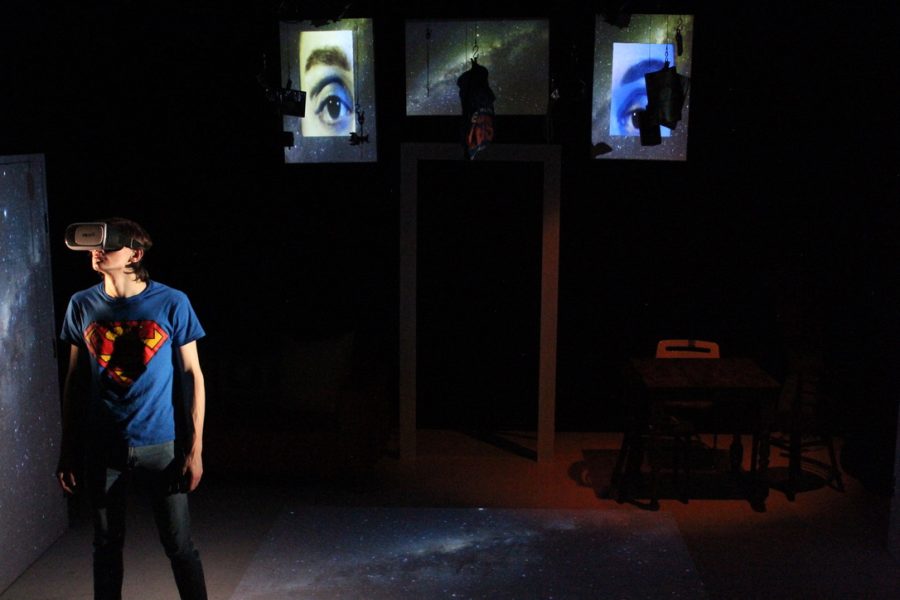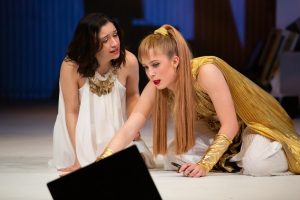‘Space Show’ and the Impact of Trauma
Fordham Theatre student director Jason Kesse ends college career with a raw, new play
COURTESY OF JASON KESSE
“Space Show” follows Jesse, who struggles with survivor’s guilt following the loss of his father in a mass shooting.
April 26, 2022
Trigger Warning: mentions of gun violence, pedophilia and mental health issues
Trauma is an intrinsic part of our society. To bring a literary work rooted in themes of pedophilia and projection to life requires care and intention. Jason Kesse, Fordham College at Lincoln Center (FCLC) ’22 and the playwright and director of “Space Show,” created an unseen narrative within Fordham Theatre’s studio season that is bent on addressing trauma.
Kesse, who is a theater major on the directing track with a second major in film and television studies, ended his Fordham Theatre career with the creation of this show. He began the process of writing “Space Show” with a blank slate — he held no expectations beyond putting on a live production before his graduation.
“Space Show” highlights the cyclical turmoil perpetuated by trauma from gun violence and mass shootings.
The show opens up by introducing the audience to a high school-age boy named Jesse Becker, played by Nate Dallimore, FCLC ’24. Jesse struggles with survivor’s guilt following the loss of his father in a mass shooting.
Jesse’s mother, Lisa Becker, played by Grace Walworth, FCLC ’24, struggles to adapt as a single mother with a child who suffers from extreme mental health issues.
Kesse and the production team of “Space Show” help establish the distant relationship between Lisa and Jesse on stage.
Dallimore seemed to step into the role of Jesse with seamless ease. Everything from the quick quiver of their lip to their constant fidgeting personifies the character.
Throughout the play, the audience witnesses a boy in extreme disarray as Jesse attempts to establish a sense of stability and intimacy with those around him. Jesse becomes close with a neighbor, Mike Harman, played by Boone Sommers, FCLC ’25.
Kesse and the production team of “Space Show” help establish the distant relationship between Lisa and Jesse on stage. Because of this lack of connection with his mother, Jesse turns to his neighbor Mike, a relationship that alludes to themes of pedophilia.
In Act 1, Scene 13, the audience watches Jesse’s heightened emotions slowly leech onto the comfortable aura that Mike exudes. Sommers plays a gruff yet kind role that is in incessant contradiction.
Sommers’ work with this character is commendable as the audience is tempted to try to understand his closed-off and hypocritical nature.
With the help of Intimacy Director JuJu Jaworski, FCLC ’24, the chemistry between Jesse and Mike radiated through the unnerved audience members. The scene reaches a climax in which Jesse calls for Mike to touch him and kisses him. Mike, unable to understand the extent of the situation, is caught off-guard while Jesse makes a humbling run.
When asked about their intentions regarding this specific scene, Kesse was sure to highlight the process of cultivating and addressing such a moment.
Kesse expressed that during the development of this production, they specifically facilitated the conversation of how the scene was intended to be interpreted. Rather than initiating a pedophilic relationship, Kesse and Jaworski attempted to establish Jesse utilizing Mike as a method of projection and physical intimacy.
“Space Show” is contingent on taking often disregarded issues head-on and allowing the audience to visualize aspects of themselves alongside the actors.
Jaworski’s intimacy work stood out in numerous scenes throughout the show. The lack of connection between Jesse and Lisa and the comfort that Mike provided to both Jesse and Lisa were important relationships throughout the play. Intimacy played a key role in these dynamics.
Walworth plays Lisa as a young, hardworking mom who struggles to define boundaries of freedom and discipline. Her use of her hands and physical movement created a distinct approach to the process of grief, or lack thereof.
“Space Show” is contingent on taking often disregarded issues head-on and allowing the audience to visualize aspects of themselves alongside the actors. As the scenes progressed, the emotions of the audience did as well.
Both Elian Rivera, FCLC ’25, and Nikki Nunziato, FCLC ’24, who played high school-age students, did an astounding job creating the perception of innocent adolescence. Even at a young age, the dark aspects of life from which the youth are shielded are still a part of reality.
In Act 2, Scene 1, after the intermission with the house lights still on and the theater filled with chatter, Dallimore walked on stage and began to speak.
At first, it wasn’t clear whether this was a part of the play or part of intermission. But the audience turned its attention to the stage and as the noises settled, Jesse’s words filled the room.
The scene is packed with raw emotion and reality. Rather than indirectly alluding to the mass shooting that killed his father, Jesse begins Act 2 by telling the audience exactly what happened in the aftermath of his father’s death. Kesse said this nontraditional approach to theater was one of his favorite parts of creating this show.
The resolution between Jesse and Lisa is symbolized by an intimate hug at their most vulnerable moments.
One of the most beautiful aspects of “Space Show” is how the creative team was able to create closure for the audience.
The resolution between Jesse and Lisa is symbolized by an intimate hug at their most vulnerable moments. Jesse has longed for a reminder that he is real and wishes for some sense of stability. Lisa, unable to process her grief or manage reality, receives a reminder from her son that she is not alone.
Both Dallimore and Warwoth do an incredible job of playing off the emotions of each other’s characters to create a sense of proximity and connection.
What sets this show apart from traditional theatrical experiences is its ambiguity.
“Space Show” is inherently unconventional in nature yet illustrates creative coordination and production through the process.
Through set design and lighting, the creative team displayed messages of projection and harsh reality. The messages of the show surround topics typically that lack discussion and invite the audience into the conversation.
What sets this show apart from traditional theatrical experiences is its ambiguity — the audience feels as if they are invited into the creative process, and they leave with their own individual takeaways.
Kesse hopes to develop “Space Show” throughout his career after Fordham through workshops and productions.













